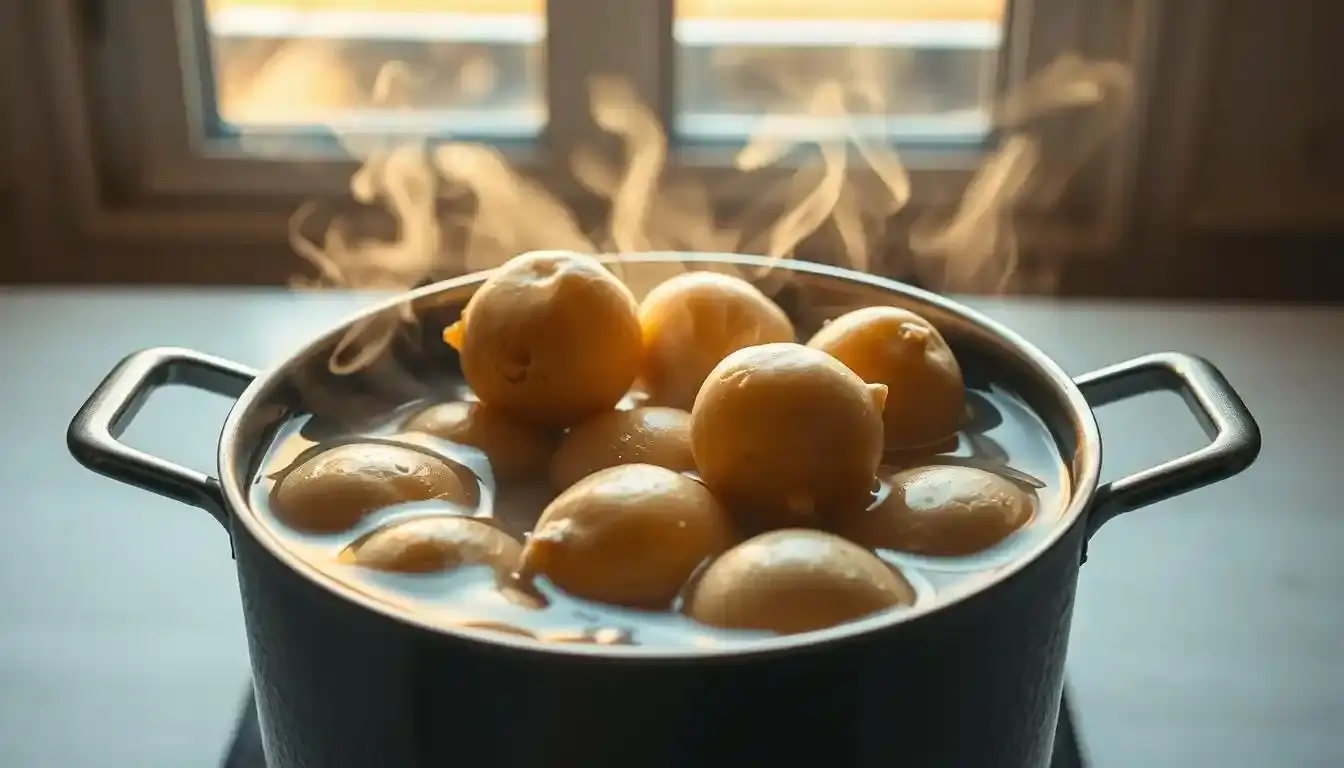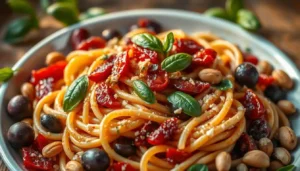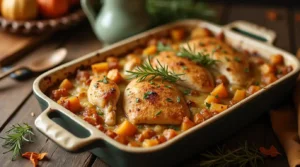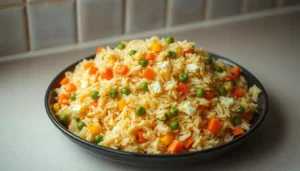How Long to Boil Potatoes – Perfect Timing for Every Type
Table of Contents
Perfectly boiled potatoes can make any meal better. They are a great side dish that’s both affordable and healthy. You can cook them by boiling, baking, or roasting.
Knowing how to cook different types of potatoes is key to getting them right. This article will cover everything from preparing potatoes to cooking them. We’ll share potato boiling tips to help you succeed every time.
By the end of this guide, you’ll be able to boil potatoes like a pro. You’ll enjoy perfectly cooked potatoes that go great with your favorite meals.
Understanding Different Potato Types
To get the best boiled potatoes, knowing the different types is important. Potatoes fall into three main categories: starchy, waxy, and all-purpose. Each type has its own special qualities that affect how it boils.
Starchy Potatoes: Russet and Idaho
Starchy potatoes, like Russet and Idaho, are light and fluffy when cooked. But, they can fall apart when boiled. This makes them less perfect for some dishes.
Texture and Cooking Properties
These potatoes soak up a lot of water and break down when boiled. This results in a soft, crumbly texture. It’s great for mashed potatoes but not for potato salads where you want them to stay firm.
Waxy Potatoes: Red, New, and Fingerling
Waxy potatoes, such as Red, New, and Fingerling, keep their shape well when boiled. They’re perfect for potato salads or boiled potatoes that stay firm.
Ideal Uses After Boiling
These potatoes are great for boiling because they keep their shape. They’re perfect for salads, boiling, or roasting. Their firmness after cooking is a favorite among chefs.
All-Purpose Potatoes: Yukon Gold and White
All-purpose potatoes, like Yukon Gold and White, are a mix of starchy and waxy. They can be used in many dishes, from boiling and roasting to mashing.
Versatility in Cooking Applications
These potatoes are versatile and can be boiled, mashed, or roasted. Their balanced starch content makes them flexible in the kitchen.
| Potato Type | Starch Content | Ideal Use |
|---|---|---|
| Starchy (Russet, Idaho) | High | Mashing, Baking |
| Waxy (Red, New, Fingerling) | Low | Boiling, Salads |
| All-Purpose (Yukon Gold, White) | Moderate | Boiling, Roasting, Mashing |
Knowing the type of potato you’re using is key to perfect boiled potatoes. By picking the right potato for your dish, you’ll get great results every time.
Essential Equipment for Boiling Potatoes
Boiling potatoes to perfection starts with the right tools. It may seem simple, but the right equipment makes a big difference. Let’s look at what you need to boil potatoes just right.
Pot Selection and Size Considerations
Choosing the right pot is key. It should be big enough to hold the potatoes and enough water to cover them. Make sure the potatoes aren’t too crowded to cook evenly.
Think about the size and type of pot you need. A large pot with a heavy bottom is best for even heat. For 2 lb. potatoes, pick a big pot and make sure the water covers them. If you’re using smaller potatoes, leave them whole. But for larger ones, peel and cut them into 1″ cubes.
Tools for Testing Doneness
To check if your potatoes are done, you’ll need some tools.
Fork Test vs. Knife Test
There are two ways to check if potatoes are cooked: the fork test and the knife test. The fork test is simple: if the fork slides in easily, they’re done. The knife test is similar: if the knife goes in without resistance, they’re cooked. The fork test is often easier to use.
Straining Options
After cooking, you’ll need to drain the potatoes. You can use a colander or just drain them in the pot.
| Equipment | Purpose | Recommendation |
|---|---|---|
| Large Pot | Boiling potatoes | Heavy-bottomed pot for even heat distribution |
| Fork or Knife | Testing doneness | Use either, but fork is generally easier |
| Colander | Straining potatoes | Essential for draining water after boiling |
Preparation Before Boiling
Before boiling potatoes, it’s key to prepare them right. This means following a few important steps. These steps can greatly affect how your boiled potatoes turn out.
Washing and Cleaning Techniques
First, wash your potatoes well. Scrub them gently under running water to get rid of dirt. This is vital to clean them before cooking.
If your potatoes are very dirty or old, soak them first. This makes scrubbing easier and more effective.
To Peel or Not to Peel
Whether to peel your potatoes depends on your recipe and taste. Leaving the skin on adds fiber and nutrients.
Skin Nutrition Benefits
Potato skins are full of antioxidants, fiber, and potassium. Keeping the skin on boosts your potatoes’ nutritional value. But, if you’re making mashed potatoes or like peeled potatoes better, peeling is okay.
Cutting Options: Whole, Halved, or Cubed
How you cut your potatoes affects their cooking time. Cutting them into smaller pieces makes them cook faster. You can boil them whole, halved, or cubed, depending on your recipe.
How Size Affects Cooking Time
The size and shape of your potato pieces change their cooking time. Boiling whole potatoes takes longer than cubed ones. You can cut them into chunks for quicker cooking, as some recipes suggest.
- Whole potatoes are great for boiling when you want to keep them whole for a recipe.
- Halving or quartering potatoes is a good middle ground for cooking time and texture.
- Cubed potatoes cook the fastest and are best for dishes needing quickly boiled potatoes.
Knowing these preparation steps helps you plan better. This ensures your potatoes are perfectly cooked every time.
The Science of Boiling Potatoes
To boil potatoes perfectly, you need to know the science behind it. It’s not just about putting them in water. You must understand how different things change the cooking process.
The journey starts with water temperature and boiling points. The water’s temperature is key when boiling potatoes. At sea level, water boils at 212°F (100°C). But, this can change with altitude. Knowing this helps you adjust your boiling method.
Water Temperature and Boiling Points
The water’s temperature affects how potatoes cook. Using cold water helps them cook evenly. It lets the heat get into the potato slowly. But, starting with hot water can cause uneven cooking. The outside might get too hot before the inside is done.
- Using cold water helps in even cooking.
- Hot water can lead to uneven cooking if not managed properly.
How Starch Behaves When Heated
Potatoes have starch that changes when heated. As they cook, the starch absorbs water, swells, and breaks down. This makes them tender. The speed of this process depends on the potato type and its starch content.
Starchy potatoes, like Russet, get fluffy when boiled. This is because their starch content breaks down a lot. On the other hand, waxy potatoes, like Red or New, keep their shape. This is because they have less starch and more moisture.
Salt and Seasoning Effects
Salt and seasonings add flavor and change the boiling process. Salt makes water boil at a slightly higher temperature. This can change how long potatoes cook and how they feel.
Flavor Absorption Rates
The speed at which potatoes absorb flavors from the water depends on several things. These include the potato type, size, and whether it’s peeled. Generally, larger potatoes should be cubed for even cooking. Peeling them first helps seasonings get in better.
- Cut larger potatoes into smaller pieces for even cooking.
- Peeling potatoes before boiling can enhance flavor absorption.
By grasping these scientific principles, you can improve your boiling potatoes technique. Whether you’re making a simple side dish or a complex recipe, these tips will help you cook perfectly every time.
Step-by-Step Boiling Potatoes Process
Boiling potatoes is a simple yet nuanced cooking task. It requires attention to detail. To achieve perfectly boiled potatoes, follow a series of steps.
Starting with Cold vs. Hot Water
Here’s the golden rule of potato boiling: Start with cold water, then bring to a boil. This method helps the potatoes cook evenly.
Starting with cold water is key for larger potatoes. It prevents the outside from getting overcooked before the inside is fully cooked.
Water Level and Potato Submersion
Make sure the potatoes are fully submerged in water. The water level should be at least an inch above the potatoes for even cooking.
Using the right amount of water is important. Too little water can cause the potatoes to stick together or to the pot.
Lid On or Off?
Whether to keep the lid on or off depends on your needs. Keeping the lid on can help bring the water to a boil faster and maintain the temperature.
Keeping it off allows for better control over the boiling process. It can also prevent the water from boiling over.
Maintaining Proper Heat
Once the water has reached a boil, you need to maintain the right heat level. A rolling boil is not always necessary; a simmer can be more appropriate for cooking potatoes evenly.
Rolling Boil vs. Simmer
A rolling boil is a vigorous boil where the water is moving rapidly. This can be useful for quickly bringing the water to a high temperature.
A simmer, on the other hand, is a gentler heat where the water is just below boiling point. This is often preferred for cooking potatoes, as it helps prevent them from breaking apart.
| Heat Level | Effect on Potatoes | When to Use |
|---|---|---|
| Rolling Boil | Quick heating, may cause potatoes to break apart | When you need to quickly bring water to a boil |
| Simmer | Gentle cooking, helps potatoes cook evenly | For most potato boiling tasks, including larger potatoes |
Perfect Timing for Every Potato Type
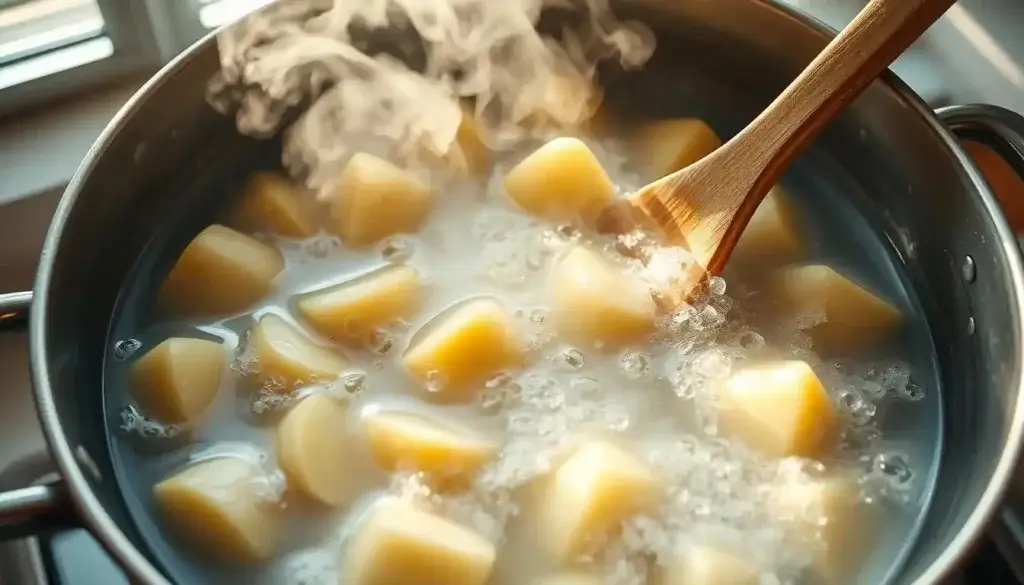
To boil potatoes perfectly, knowing the cooking times for different types and sizes is key. The time needed can change a lot based on the potato type, size, and altitude. Understanding these factors helps you get perfect boiled potatoes every time.
Whole Large Potatoes
Boiling whole large potatoes takes 15 to 30 minutes, depending on the type. For example:
- Russet potatoes usually need 15-20 minutes to cook.
- Yukon Gold potatoes might take 20-25 minutes.
- Red potatoes often need 25-30 minutes.
Medium-Sized Cubed Potatoes
Cubed potatoes cook faster than whole ones. The exact time depends on the cube size:
- 1-inch cubes take 10-15 minutes to cook.
- 2-inch chunks might need 15-20 minutes.
Baby and New Potatoes
Baby and new potatoes are tender and cook quickly:
- Whole baby potatoes usually take 15-20 minutes to cook.
- Halved baby potatoes cook faster, in 10-15 minutes.
Some say baby potatoes can be ready in 10-12 minutes. Small potatoes might take 15-20 minutes. Larger cubed potatoes can need 30-40 minutes.
Adjustments for Altitude
At high altitudes, you’ll need to adjust cooking times. Water boils slower at higher elevations, affecting cooking times. You might need to add a few minutes for every 1,000 feet of altitude.
Visual and Texture Cues for Doneness
Timing is important, but checking for doneness visually and by texture is also key:
- Potatoes are done when they’re tender when pierced with a fork.
- The skin may start to wrinkle or crack slightly.
- For cubed potatoes, check that they’re uniformly tender.
By using the right cooking times and these visual and texture cues, you can get perfect boiled potatoes every time, no matter the type or size.
Common Boiling Mistakes to Avoid
Boiling potatoes is easy, but you need to pay attention to avoid mistakes. These errors can ruin your dish. Knowing what to watch out for helps you cook perfect potatoes every time.
Overcooking Issues and Solutions
Overcooking potatoes is a big mistake. Starchy potatoes like russets can fall apart if overcooked. Keep an eye on them as they boil. Check if they’re done by inserting a fork or knife; if it slides in easily, they’re ready.
Rescuing Overcooked Potatoes
Rescuing Overcooked Potatoes
If your potatoes are overcooked, you can fix them. Mash them or use them in a soup or stew. For a fancy dish, make potato pancakes or latkes.
Undercooking Problems and Fixes
Undercooked potatoes are hard and not tasty. To avoid this, cut potatoes into the same size. If they’re not done, just boil them a bit longer until they’re tender.
Uneven Cooking Troubleshooting
Uneven cooking happens when potatoes are different sizes or not fully submerged. Cut potatoes into the same size and make sure they’re covered in water. Stirring them while boiling helps cook them evenly.
Size Consistency Importance
Keeping potatoes the same size is key for even cooking. This way, they cook at the same rate. It’s very important when boiling a lot of potatoes.
| Potato Type | Common Mistake | Solution |
|---|---|---|
| Starchy Potatoes (Russet, Idaho) | Overcooking, leading to disintegration | Check frequently for doneness, use a timer |
| Waxy Potatoes (Red, New, Fingerling) | Undercooking, resulting in hardness | Boil until tender, check with a fork |
| All-Purpose Potatoes (Yukon Gold, White) | Uneven cooking due to size differences | Cut into uniform sizes, stir occasionally |
Knowing these common mistakes helps you cook perfect potatoes every time. Whether it’s a simple side or a complex dish, mastering boiling potatoes is a valuable skill.
After Boiling: Handling and Serving
After boiling your potatoes, it’s important to handle and serve them right. The right steps can greatly improve your dish’s texture and taste.
Draining Techniques
Draining is the first thing to do after boiling. To keep the starch for dishes like mashed potatoes or potato salads, drain them correctly. Drain potatoes in a colander and let them cool for about 10 minutes. This helps remove excess moisture, which is key for the right consistency.
For recipes like boiled potatoes recipe, drain them right away. You can also gently shake the colander to get rid of extra water.
How you drain your potatoes affects their starch content. This is important for certain recipes. For mashed potatoes, keeping some starch helps them be creamier. But for boiled potato salads, you need to drain well to avoid sogginess.
Cooling Methods
Cooling your boiled potatoes is as important as boiling them. To stop cooking and prevent mushiness, cool them down fast. Spreading them on a baking sheet helps cool them quicker.
Storage of Boiled Potatoes
If you won’t use your boiled potatoes right away, store them properly. Store leftover boiled potatoes in the refrigerator for up to 4 days. Cool them completely before refrigerating to avoid bacterial growth.
Refrigeration Best Practices
When storing boiled potatoes, use an airtight container to keep them fresh. It’s also smart to label the container with the date. This helps you remember how long they’ve been stored.
By following these boiling potatoes instructions, you’ll get perfect boiled potatoes every time. They’re ready for your favorite recipes.
Nutritional Benefits of Boiled Potatoes
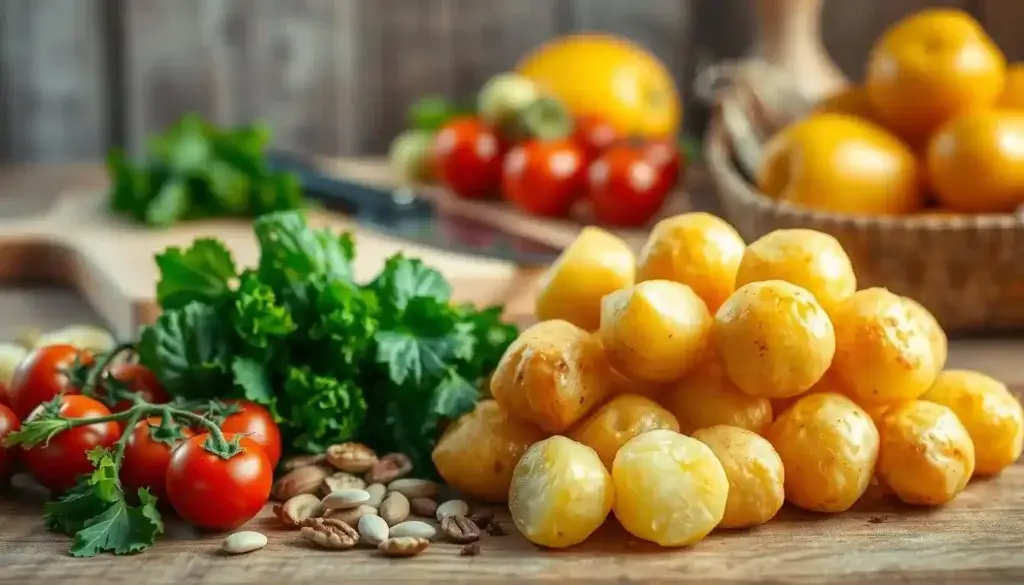
Boiled potatoes are packed with vitamins, minerals, and health perks. They are a key part of a balanced diet. Boiling is better than frying because it doesn’t add bad oils or fats.
Vitamin and Mineral Content
Boiled potatoes are full of important vitamins and minerals. They are rich in potassium, which is good for blood pressure and bones. They also have vitamin C, but the amount depends on the potato and how it’s cooked. Plus, they have fiber, more so if you keep the skins on.
Caloric Value Compared to Other Cooking Methods
Boiling potatoes is better than frying because it’s lower in calories. A medium-sized boiled potato has about 100-110 calories. Frying, on the other hand, adds a lot of calories because of the oils.
Dietary Considerations
Boiled potatoes are good for many diets. They are low in fat and can be made without too much salt or sugar. For those watching their sodium, boiled potatoes are a low-sodium and heart-healthy option if seasoned right.
Low-Sodium and Heart-Healthy Options
To make boiled potatoes even better, use herbs and spices instead of salt. This cuts down on sodium and adds flavor without extra calories. Also, keeping the skins on boosts their fiber, which is good for your heart.
In summary, boiled potatoes are full of nutrients and are great for a healthy meal. They are rich in vitamins, minerals, and fiber, and low in calories when boiled. This makes them a nutritious food choice.
Recipe Ideas for Perfectly Boiled Potatoes
Perfectly boiled potatoes are great for many dishes. You can enjoy them whole with butter and herbs. Or, use them to make mashed potatoes, potato salad, or potato casserole. The possibilities are endless, and the key is to start with perfectly boiled potatoes.
Classic Mashed Potatoes
Mashed potatoes are a comfort food favorite. To make them, boil potatoes until tender. Then, mash with butter, milk, and seasonings. For a richer taste, add grated cheese or sour cream.
- Boil potatoes until tender
- Mash with butter, milk, and seasonings
- Add optional ingredients like grated cheese or sour cream for extra flavor
Potato Salads
Potato salad is a versatile dish. You can mix boiled potatoes with various ingredients like vegetables, herbs, and dressings. A classic recipe combines boiled potatoes with mayonnaise, mustard, and diced onions.
| Ingredient | Quantity |
|---|---|
| Boiled Potatoes | 4-6 medium-sized |
| Mayonnaise | 1/2 cup |
| Diced Onions | 1/4 cup |
Simple Seasoned Boiled Potatoes
Boiled potatoes can be seasoned with herbs and spices for extra flavor. Try tossing them with melted butter, chopped herbs like parsley or chives, and a bit of salt and pepper.
Herb and Butter Variations
Try different herb and butter combinations to find your favorite. Some ideas include:
- Garlic and Rosemary: Mix minced garlic with melted butter and chopped rosemary.
- Lemon and Chives: Combine lemon zest, lemon juice, and chopped chives with melted butter.
Conclusion
Boiling potatoes is a basic skill that makes many dishes better. It can turn simple sides into main courses. By knowing the different types of potatoes and using the right tools, you can get perfect boiled potatoes every time.
Boiling potatoes well means understanding their unique traits. Whether you’re boiling whole potatoes or cubed ones, the basics stay the same. Use the right pot, control the water, and watch the heat to get them just right.
With time, you’ll get better at boiling potatoes to the perfect doneness. This opens up a world of possibilities in cooking. From mashed potatoes to potato salads, boiled potatoes are incredibly versatile. By following the tips here, you’ll improve your boiling skills and expand your cooking abilities.
FAQ
What is the best way to boil potatoes?
Start with cold water for boiling potatoes. Use a large pot to hold them in a single layer. Keep the boil gentle and add salt for flavor.
How do I know when boiled potatoes are done?
Check if potatoes are tender by poking them with a fork. If a knife or skewer slides in easily, they’re cooked.
Can I boil potatoes with the skin on?
Yes, boiling potatoes with skin on is fine. It keeps nutrients and flavor in. Just make sure to wash them well first.
How long does it take to boil diced potatoes?
Boiling time for diced potatoes depends on size. Small to medium pieces usually take 10-15 minutes to soften.
What type of potatoes are best for boiling?
Waxy potatoes like red or new ones are best for boiling. They keep their shape well. Yukon Golds are also good.
Can I add salt to the water when boiling potatoes?
Yes, adding salt to the water boosts flavor. Use 1-2 tablespoons of salt for every 4 cups of water.
How do I prevent boiled potatoes from becoming mushy?
To avoid mushy potatoes, don’t overcook them. Check often and drain them when tender.
Can I boil potatoes in advance?
Yes, you can boil potatoes ahead of time. Boil them until slightly undercooked, then cool and refrigerate or store in an airtight container.
How do I store leftover boiled potatoes?
Cool boiled potatoes to room temperature, then refrigerate in an airtight container. They last 3-5 days in the fridge.
Are boiled potatoes a healthy option?
Boiled potatoes are healthy, low in calories, and full of vitamins and minerals. But watch out for added butter or sour cream, which can up calorie count.
Enjoyed the recipe? We’d love to hear your thoughts! Leave a review and share your feedback in the comments – your input helps us bring you even more delicious dishes!
There are no reviews yet. Be the first one to write one.

